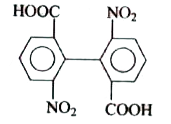Out of the following the alkene that exhibits optical isomerism is
3-methyl-2-pentene
4-methyl-1-pentene
3-methyl-1-pentene
2-methyl-2-pentene
The correct Answer is:C
To determine which alkene exhibits optical isomerism, we need to identify if any of the given alkenes contain a chiral carbon. A chiral carbon is defined as a carbon atom that is bonded to four different substituents.
1. Identify the Alkenes: The question provides four alkenes. We will analyze each one to see if it has a chiral carbon.
- Alkene 1: 3-methyl-2-pentene
- Alkene 2: 4-methyl-1-pentene
- Alkene 3: 3-methyl-1-pentene
- Alkene 4: 2-pentene
2. Draw the Structures: We will draw the structures of each alkene to visualize the arrangement of atoms.
- 3-methyl-2-pentene:
CH3−CH=C(CH3)−CH2−CH3
- 4-methyl-1-pentene:
CH2=CH−CH2−CH(CH3)−CH3
- 3-methyl-1-pentene:
CH2=CH−CH(CH3)−CH2−CH3
- 2-pentene:
CH3−CH=CH−CH2−CH3
3. Analyze Each Structure for Chirality:
- Alkene 1 (3-methyl-2-pentene): The carbon with the double bond (C2) cannot be chiral as it is bonded to two identical methyl groups. No chiral carbon.
- Alkene 2 (4-methyl-1-pentene): The carbon with the double bond (C1) is also not chiral as it is bonded to two hydrogen atoms. No chiral carbon.
- Alkene 3 (3-methyl-1-pentene): The carbon at position 3 is bonded to:
- Ethyl group (C2H5)
- Methyl group (CH3)
- Hydrogen (H)
- The rest of the carbon chain (C1)
This carbon is a chiral center because all four substituents are different. Thus, this alkene can exhibit optical isomerism.
- Alkene 4 (2-pentene): The carbon with the double bond (C2) is not chiral as it is bonded to two identical groups. No chiral carbon.
4. Conclusion: Only 3-methyl-1-pentene has a chiral carbon and can exhibit optical isomerism.
Final Answer:
The alkene that exhibits optical isomerism is 3-methyl-1-pentene.
- Alkene 1: 3-methyl-2-pentene
- Alkene 2: 4-methyl-1-pentene
- Alkene 3: 3-methyl-1-pentene
- Alkene 4: 2-pentene
- 3-methyl-2-pentene:
CH3−CH=C(CH3)−CH2−CH3
- 4-methyl-1-pentene:
CH2=CH−CH2−CH(CH3)−CH3
- 3-methyl-1-pentene:
CH2=CH−CH(CH3)−CH2−CH3
- 2-pentene:
CH3−CH=CH−CH2−CH3
- Alkene 1 (3-methyl-2-pentene): The carbon with the double bond (C2) cannot be chiral as it is bonded to two identical methyl groups. No chiral carbon.
- Alkene 2 (4-methyl-1-pentene): The carbon with the double bond (C1) is also not chiral as it is bonded to two hydrogen atoms. No chiral carbon.
- Alkene 3 (3-methyl-1-pentene): The carbon at position 3 is bonded to:
- Ethyl group (C2H5)
- Methyl group (CH3)
- Hydrogen (H)
- The rest of the carbon chain (C1)
This carbon is a chiral center because all four substituents are different. Thus, this alkene can exhibit optical isomerism.
- Alkene 4 (2-pentene): The carbon with the double bond (C2) is not chiral as it is bonded to two identical groups. No chiral carbon.
The alkene that exhibits optical isomerism is 3-methyl-1-pentene.
Topper's Solved these Questions
Similar Questions
Knowledge Check
The alkene that exhibits geometrical isomerism is
ApropeneB2-methylpropeneC2-buteneD2-methyl-2-buteneWhich of the following acids does not exhibit optical isomerism?
AMaleic acidBα-amino acidsCLactic acidDTartaric acidWhich of the following compounds exhibit optical isomerism?
A BH2C=C=CH2C
BH2C=C=CH2C D
D
Which of the following can exhibit geometrical isomerism?
View SolutionWhich of the following will exhibit geometrical isomerism?
View SolutionWhich of the following will not be able to show optical isomerism (enantiomerism)?
View SolutionWhich of the following complex compound exhibits geometrical isomerism?
View SolutionWhich of the following compounds can exhibit geometrical isomerism?
View Solution
